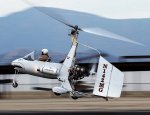Hover: remain in one place in the air.
An
autogyro (from
Greek αὐτός and γύρος, "self-turning"), also known as a
gyroplane or
gyrocopter, is a type of
rotorcraft that uses an unpowered rotor in free
autorotation to develop
lift. Forward
thrust is provided independently, typically by an engine-driven
propeller. While similar to a
helicopter rotor in appearance, the autogyro's rotor must have air flowing across the rotor disc to generate rotation, and the air flows upwards through the rotor disc rather than down.
If it has a powered rotor it is a helicopter, not a gyroplane and you need a helicopter license to fly it unless it is an ultralight.
Sec. 103.1 Applicability.
This part prescribes rules governing the operation of ultralight vehicles
in the United States. For the purposes of this part, an ultralight vehicle
is a vehicle that:
(a) Is used or intended to be used for manned operation in the air by a
single occupant;
(b) Is used or intended to be used for recreation or sport purposes only;
(c) Does not have any U.S. or foreign airworthiness certificate; and
(d) If unpowered, weighs less than 155 pounds; or
(e) If powered:
(1) Weighs less than 254 pounds empty weight, excluding floats and safety
devices which are intended for deployment in a potentially catastrophic
situation;
(2) Has a fuel capacity not exceeding 5 U.S. gallons;
(3) Is not capable of more than 55 knots calibrated airspeed at full
power in level flight; and
(4) Has a power-off stall speed which does not exceed 24 knots calibrated
airspeed.
If it has a powered rotor it will likely need an anti-torque rotor unless it is jet tip or coaxial.
To fly well it will need an inflight adjustable pitch rotor.
A gyroplane with enough power will fly in one spot over the ground at somewhere around twenty miles per hour. Some people call this hovering.
Some gyroplanes can do a jump takeoff (vertical takeoff) but will not hover.
I wish you all the best on your aviation adventure.



